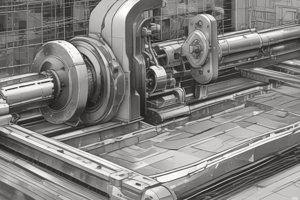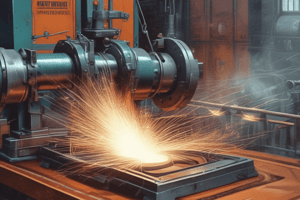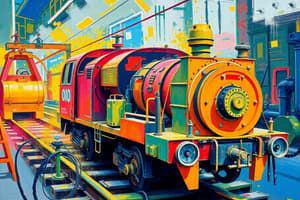Podcast
Questions and Answers
What is the primary function of the worktable in a grinding machine?
What is the primary function of the worktable in a grinding machine?
- To move the grinding wheel
- To apply pressure to the workpiece
- To support and locate the workpiece (correct)
- To rotate the workpiece
Which type of abrasive is commonly used for grinding hardened steel?
Which type of abrasive is commonly used for grinding hardened steel?
- Silicon carbide
- Alumina
- Cubic boron nitride (correct)
- Ceramic alumina
What is the primary advantage of centerless grinding over other grinding methods?
What is the primary advantage of centerless grinding over other grinding methods?
- Reduced grinding wheel wear
- No need for workpiece centering (correct)
- Increased precision
- Improved surface finish
What is the primary factor in selecting a grinding wheel for a specific grinding operation?
What is the primary factor in selecting a grinding wheel for a specific grinding operation?
What is the primary characteristic of a grinding wheel that affects its cutting action?
What is the primary characteristic of a grinding wheel that affects its cutting action?
Which type of cylindrical grinding is used to grind the internal diameter of a bearing component?
Which type of cylindrical grinding is used to grind the internal diameter of a bearing component?
What is the primary purpose of the tailstock in a cylindrical grinding machine?
What is the primary purpose of the tailstock in a cylindrical grinding machine?
Which grinding operation is used to grind a tapered surface on a shaft?
Which grinding operation is used to grind a tapered surface on a shaft?
Flashcards are hidden until you start studying
Study Notes
Grinding Machines
- Types:
- Surface grinders
- Cylindrical grinders
- Centerless grinders
- Tool and cutter grinders
- Special purpose grinders
- Components:
- Grinding wheel
- Worktable
- Spindle
- Tailstock
- Cross-feed
- Operations:
- Traverse grinding
- Plunge grinding
- Angular grinding
Abrasive Grinding
- Definition: Grinding process using an abrasive material to remove material from a workpiece
- Types of abrasives:
- Alumina (Al2O3)
- Silicon carbide (SiC)
- Ceramic alumina (Al2O3 + additives)
- Diamond
- Cubic boron nitride (cBN)
- Characteristics:
- Hardness
- Grain size
- Bond type (vitrified, resinoid, metal)
- Porosity
Centerless Grinding
- Definition: Grinding process where the workpiece is supported by a work rest and rotated between two wheels
- Types:
- Through-feed grinding
- In-feed grinding
- End-feed grinding
- Advantages:
- High precision
- High productivity
- No need for workpiece centering
- Applications:
- Bearing components
- Shafts
- Axles
Grinding Wheels
- Definition: Abrasive tool used for grinding operations
- Components:
- Abrasive grains
- Bonding material
- Filler material
- Characteristics:
- Grain size
- Bond type
- Porosity
- Wheel speed
- Selection criteria:
- Workpiece material
- Grinding operation
- Wheel speed
- Coolant used
Cylindrical Grinding
- Definition: Grinding process where the workpiece is rotated and moved longitudinally between two wheels
- Types:
- External cylindrical grinding
- Internal cylindrical grinding
- Operations:
- Traverse grinding
- Plunge grinding
- Taper grinding
- Applications:
- Axles
- Shafts
- Gears
- Bearing components
Grinding Machines
- Grinding machines types include surface grinders, cylindrical grinders, centerless grinders, tool and cutter grinders, and special purpose grinders
- Main components of grinding machines are grinding wheel, worktable, spindle, tailstock, and cross-feed
- Grinding machines perform traverse grinding, plunge grinding, and angular grinding operations
Abrasive Grinding
- Abrasive grinding is a process that uses an abrasive material to remove material from a workpiece
- Types of abrasives used in grinding are alumina, silicon carbide, ceramic alumina, diamond, and cubic boron nitride
- Characteristics of abrasives include hardness, grain size, bond type, and porosity
Centerless Grinding
- Centerless grinding is a process where the workpiece is supported by a work rest and rotated between two wheels
- Types of centerless grinding are through-feed grinding, in-feed grinding, and end-feed grinding
- Centerless grinding offers high precision, high productivity, and eliminates the need for workpiece centering
- Centerless grinding is commonly used for bearing components, shafts, and axles
Grinding Wheels
- Grinding wheels are abrasive tools used for grinding operations
- Grinding wheel components include abrasive grains, bonding material, and filler material
- Characteristics of grinding wheels include grain size, bond type, porosity, and wheel speed
- Selection of grinding wheels depends on workpiece material, grinding operation, wheel speed, and coolant used
Cylindrical Grinding
- Cylindrical grinding is a process where the workpiece is rotated and moved longitudinally between two wheels
- Types of cylindrical grinding include external cylindrical grinding and internal cylindrical grinding
- Cylindrical grinding operations include traverse grinding, plunge grinding, and taper grinding
- Cylindrical grinding is commonly used for axles, shafts, gears, and bearing components
Studying That Suits You
Use AI to generate personalized quizzes and flashcards to suit your learning preferences.





